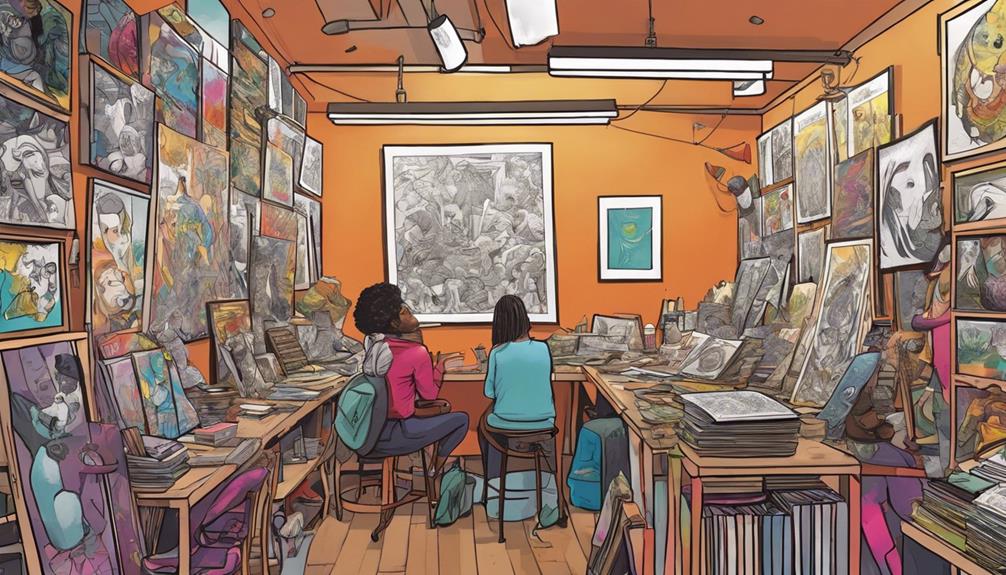To release your creativity and master art business success, start by defining your unique identity. Identify your specific style and develop a strong USP. Build an engaging online portfolio with high-quality images and detailed descriptions. Use effective marketing techniques like social media and email to connect with your audience. Don't forget to keep track of your finances and network with other artists and collectors. Managing customer relationships is key, so personalize experiences and encourage feedback. Stay adaptable and embrace continuous learning to stay ahead. There's so much more to explore that can transform your art business into a thriving success. In addition, pay attention to your branding and logo design principles. Your logo should reflect your unique identity and style, and be easily recognizable. It’s important to consistently apply your branding across all your marketing materials and online platforms to create a strong and cohesive brand presence. Remember, the key to art business success lies in staying true to your artistic vision while also effectively managing the business side of things.
Key Takeaways
- Define your unique artistic identity and develop a compelling USP to stand out in a competitive market.
- Build a stunning online portfolio with high-quality images and detailed descriptions that reflect your artistic journey.
- Utilize social media and email marketing to engage with your audience and promote your artworks effectively.
- Network through art fairs, workshops, and local exhibitions to connect with collectors and fellow artists.
Defining Your Unique Identity
Defining your unique identity as an artist is essential for carving out a niche that sets you apart in a competitive market.
You need to pinpoint your specific art style or medium, whether it's painting, sculpture, or digital work, and develop a unique selling proposition (USP).
Think about what drives your art and the motivations behind it—this clarity will help you identify your unique selling points that make you different from others.
Understanding your target market is vital, too; you want to create a brand identity that resonates with them.
Building Your Online Portfolio

Creating a compelling online portfolio is essential for showcasing your artwork and attracting potential buyers. Start by selecting high-quality images that capture your work's essence.
Organize your pieces in a way that reflects your style and artistic journey, making it easy for visitors to navigate. Include detailed descriptions for each artwork, highlighting the inspiration and techniques used.
Don't forget to add an engaging artist statement that conveys your unique identity and vision. Also, make sure your contact information is easily accessible, encouraging inquiries and commissions.
Regularly update your portfolio with new works and exhibitions to keep your audience engaged. Finally, leverage social media to drive traffic to your portfolio, ensuring your art reaches a wider audience.
Effective Marketing Techniques

Harnessing innovative marketing techniques can greatly enhance your visibility and sales as an artist. Start by identifying a marketing style that resonates with your creativity—think outside the box!
Utilize social media platforms to engage with your audience, sharing your artistic process and behind-the-scenes insights. Email marketing can also be effective; keep your subscribers updated on new works and exclusive offers.
Collaborate with influencers and fellow artists to expand your reach, and consider hosting virtual art shows to showcase your pieces. Don't shy away from paid advertising on platforms like Instagram or Facebook.
Financial Health and Planning

Understanding your financial health is essential for sustaining a successful art business and making informed decisions that drive growth.
Start by tracking your income and expenses diligently; this gives you a clear picture of your financial situation.
Create a budget that outlines both your expected costs and potential investments.
Consider exploring funding options like grants or art-specific loans to support your endeavors.
Analyze your sales data regularly to refine your strategies and set competitive pricing based on market research.
Don't forget to conduct regular financial reviews; these can uncover opportunities for growth and help you maintain long-term sustainability.
Networking Opportunities

Expanding your network can reveal new opportunities for collaboration and exposure in the art world. Attend art fairs, exhibitions, and workshops to connect with fellow artists, dealers, and potential collectors. Engaging with local businesses can lead to partnerships that enhance your visibility.
Here's a quick reference to networking opportunities:
| Networking Events | Benefits |
|---|---|
| Art Fairs | Meet collectors |
| Workshops | Skill development |
| Online Communities | Collaboration |
| Local Exhibitions | Build relationships |
Managing Customer Relationships

Building strong customer relationships enhances your art business by fostering loyalty and encouraging repeat purchases. To achieve this, develop a system for managing customer interactions and feedback. Personalize experiences and follow up after purchases to show appreciation.
Encourage reviews and testimonials; they build credibility and trust. Implement loyalty programs to reward repeat customers, making them feel valued.
Utilize customer data effectively to tailor your marketing efforts and product offerings, ensuring a more targeted approach that resonates with your audience. Regularly engage with customers through newsletters or social media updates, keeping them informed about new works and events.
Embracing Continuous Learning

In today's fast-paced art world, staying updated on industry trends and innovations is essential for your growth as an artist.
Embracing continuous learning allows you to experiment with new techniques and mediums, keeping your work fresh and relevant.
Attend workshops, seminars, and online courses to enhance your skills and knowledge. Gather feedback from your audience to refine your offerings and better meet their needs.
Regularly assess your business strategies, learning from both successes and mistakes. This mindset fosters resilience, enabling you to adapt to challenges and seize new opportunities.
Adapting to Market Changes

Adapting to market changes is essential for maintaining relevance and thriving in the dynamic art world you're maneuvering. Keep an eye on emerging trends, new technologies, and shifts in consumer preferences.
Stay flexible in your approach; if a particular medium or style gains popularity, consider incorporating it into your work. Engage with your audience through social media to understand their desires and feedback—this helps you tailor your offerings effectively.
Participate in workshops or industry events to stay informed and network with other artists. Remember, the ability to pivot when necessary not only strengthens your brand but also opens doors to new opportunities.
Embrace change, and you'll find yourself ahead in this ever-evolving landscape.
Conclusion
In your journey to artistic achievement, remember that passion paired with persistence paves the path to success.
By defining your distinct identity and developing a dynamic online presence, you'll draw in devoted fans and collectors.
Don't shy away from seeking savvy marketing strategies and solid financial planning.
Stay open to learning and adapting, as the art world is ever-evolving.
So, release your creativity, cultivate connections, and watch your art business flourish!









